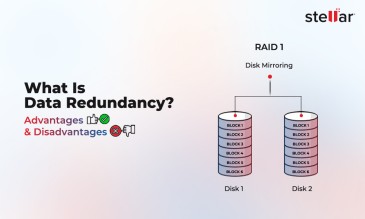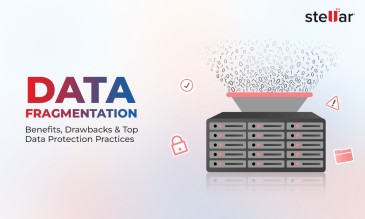Long story short: SAN is short for Storage Area Network. It is a data storage solution wherein all data in the SAN is centralized into a single pool that can be accessed by multiple servers/ nodes/ computers.
Like everything in the IT sector, SANs are prone to data loss, and on such occasions, we need to employ SAN data recovery solutions, which are described later on in the article.
Each of the computers/ servers on the SAN can access data in the SAN pool as if it was stored on local drives that were connected directly to the computer/ node. A little more detail is given below.
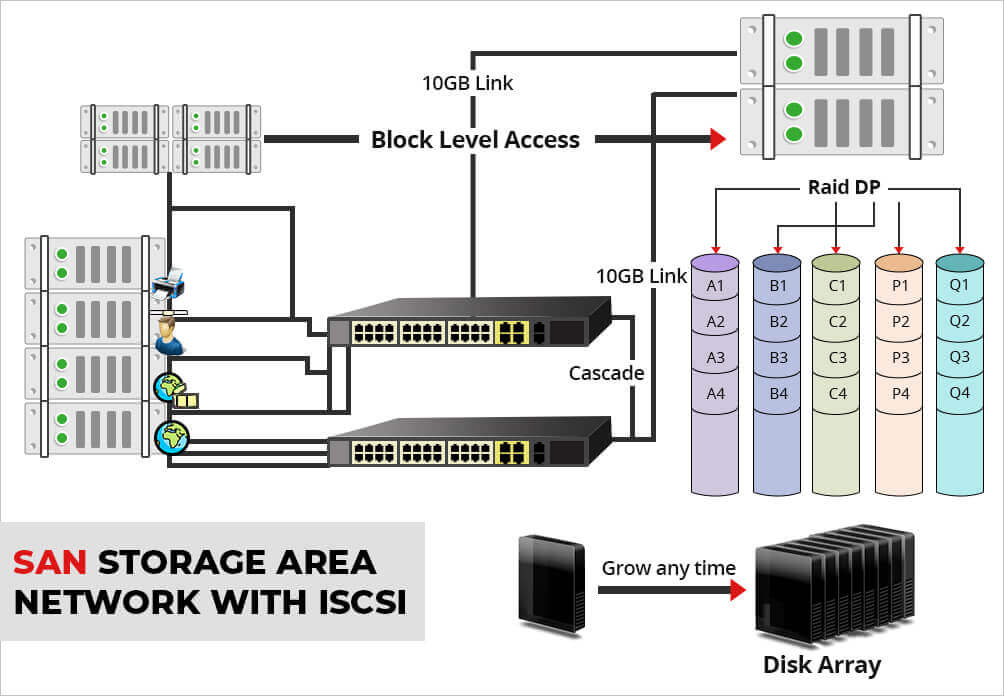
What is A SAN?
A SAN is a scalable, high-speed, extremely specialized network that provides access to storage drives or devices that are on the network.
How does SAN work: The main elements of a SAN are:
- Storage Devices,
- Switches,
- Hosts, and
- Accessors (other virtual clients).
The different elements of a SAN are connected to each other via a veritable cocktail of topologies and protocols. Owing to the nature of the technology, a SAN may span multiple physical locations.
SANs present storage to the client or host in a manner that, to the accessor, the storage appears to be attached locally to their machine, and not as NAS (network attached storage).
In the image above, you will be able to see a typical storage area network.
The version of RAID used in the actual storage servers is variable and depends on what your use case is.
Note: No matter the RAID used, the SAN data recovery process is the same.
SANs work on either Fiber Channel Technology (FC) or on Internet Small Computing System Interface (ISCSI), with FC being faster and costlier, and ISCSI being cost-effective.
If you want more information on the basics of SAN deployment, you can read this redbook by IBM.
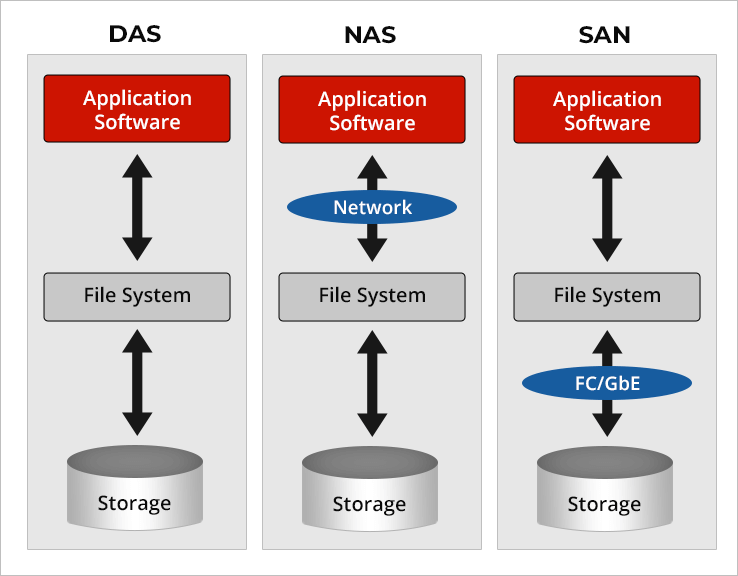
Additional Reading: Limitation of NAS, What is SAN, NAS versus SAN
Advantages Of A SAN
The following are the (bespoke and unique) benefits that SANs have, and that make SAN data recovery in case of a crash easier:
- Reduces Bandwidth Issues: LAN oriented storage solutions tend to bottleneck after a certain scale, which does not happen with SAN solutions because it takes on a large block of networked traffic.
- Assisted Multichannel Disaster Recovery: It is possible to perform SAN data recovery across a host of applications, whether the loss was caused by an act of god, server crash, human error, or malware attack; this is not possible with other storage solutions as easily.
- Easier Deployment and Management: Because of the chunked nature of the SAN, scalability is greatly improved compared to other networks, and it is easier to manage owing to the centralization of everything.
- Improved Application Performance: SANs channel storage processing, and shift them onto separate networks, which provides a marked increase in performance and decrease in load times.
- Foolproof Backup And Security: SANs allow for backups from several locations to be consolidated onto a single backup server, allowing for hassle-free backups. Also, should anything happen to your LAN, your data is now on a whole different network, meaning that it is safe, and makes it easier to deploy SAN data recovery solutions.
In-depth information on the advantages of a SAN can be found here, and the BMSIT course handbook on SANs here.
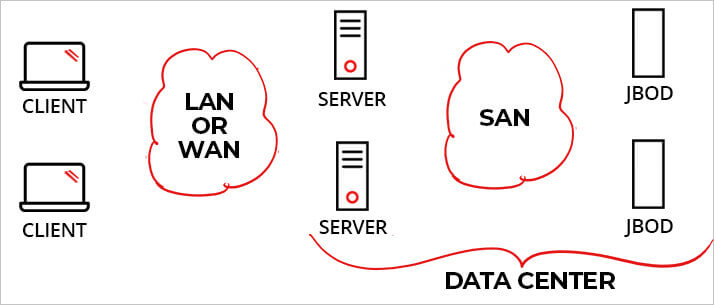
SAN Data Recovery Services
If your SAN ever decides to quit on you, the singular best option for anyone is to seek professional help to aid your SAN data recovery.
IMPORTANT: Do not attempt DIY recovery of your SAN if it fails.
When your SAN fails, you are not the only person whom this affects; it is everyone who accesses any data on your SAN – even your customers.
This tenterhook situation is the reason why it is not recommended to mess around with your SAN if you lose data, but to deploy commercial SAN data recovery solutions instead – these are curated by industry experts with decades of experience.
The financial investment on your part will be well worth it when an external firm takes on the headache and responsibility of SAN data recovery for your organization.
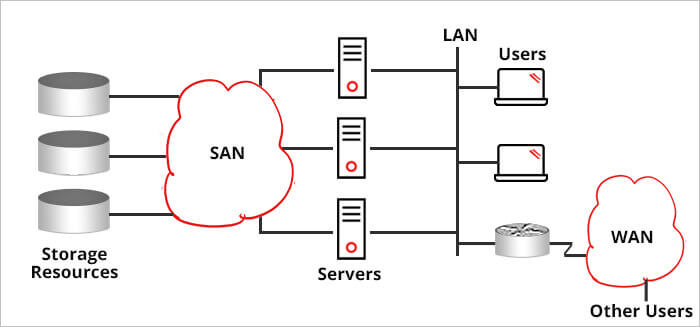
Factors That Affect SAN Recovery
The various factors that affect SAN recovery and influence SAN data recovery are:
| S.No. | Factor(s) That Affect SAN Recovery | Description |
| 1. | Drive Crashes (Simultaneous or Linear) | After any kind of extraordinary stress on the system (outages, fluctuations, hacks), hard disks in the JBOD or RAID are prone to crashing. |
| 2. | Physical Disk Trauma | Heat, Moisture, Impact, and Magnetization are all factors that affect SAN recovery, but it is possible to get data back, even in these situations. |
| 3. | Element Failure | Any of the elements of a SAN may fail, causing disruptions across the entire SAN, as part of cause and effect. |
| 4. | Software Failure | Any of the utilities that control your SAN, that are the interface for the accessor or that coordinate between SAN elements may crash or fail, causing disruptions. |
Common Types Of Storage System Failures
These are the ten most common types of storage system failures:
- Hard Disk Issues
- Failed OS or BIOS
- Network Bottlenecks
- Virtualization Management
- Server Posting Errors
- Malware or Ransomware Attacks
- PSU Failures
- Controller Issues
- Stripping Corruption
- Deleted Partitions
All of the above situations can easily be remedied by using SAN data recovery solutions. These can rectify database and database access loss, email servers, application crashes, and more.
The server type used in your SAN deployment solution may also have specific problems of its own which affect SAN data recovery; for example HP LeftHand servers have posting errors (mentioned above) crop up more frequently than, say, a Dell EMC, Drobo, or a Netapp server.
Additional Reading: Difference between NAS and SAN and their storage architectures
Closing Notes
The most important thing to remember is that DIY recovery attempts of your SAN can, and usually do result in bigger catastrophes, which is why the smart move is to call in the experts when problems are noticed, and let them do the heavy lifting.
At the end of the day, SAN deployment relies on machines, which are not infallible. If these machines ever do fail, the solution is simple: call in the pros.
About The Author

Online Marketing Expert & Content Writer







